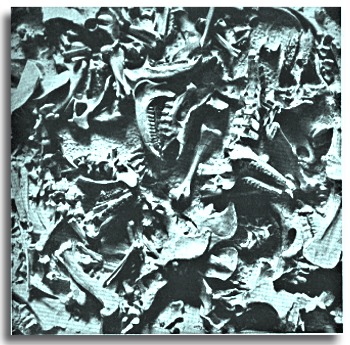
Agate Spring Quarry -
In Sioux county Nebraska, on the south side of the Niobrara River, in Agate Springs Quarry, is a fossil bearing deposit up to twenty inches thick. The state of the bones indicate a long and violent transportation before they reached their final resting place. '...the fossils are in such remarkable profusion, in places, as to form a veritable pavement of interlacing bones, very few of which are in their natural articulation with one another,' says R.S. Lull, director of the Peabody Museum at Yale, in his book on fossils.'
The profusion of bones in Agate Springs Quarry may be judged by a single block now in the American Museum of Natural History in New York, this block contains about a hundred bones to the square foot. There is no way of explaining an aggregation of fossils as a natural death retreat of animals of various genera.
The animals found were mammals. The most numerous was the small twin horned rhinoceros (Diceratherium). There was another extinct animal (Moropus) with a head not unlike that of a horse but with heavy legs and claws like that of a carnivorous animal. And bones of a giant swine that stood six feet high (Dinohyus hollandi) were also unearthed.
The Carnegie Museum, which likewise excavated in Agate Spring Quarry, in a space of 1350 square feet found 164,000 bones or about 820 skeletons. A mammal skeleton averages 200 bones. This area represents only one-twentieth of the fossil bed in the quarry, suggesting to Lull that the entire area would yield about 16,400 skeletons of the twin-horned rhinoceros, 500 skeletons of the clawed horse, and 100 skeletons of the giant swine.
A few miles to the east, in another quarry were found skeletons of an animal which, because of its similarity to two extant species, is called a gazelle camel (Stenomylus). A herd of these animals was destroyed in a disaster. ~ the transportation was in a violent cataract of water, sand, and gravel, that left marks on the bones. Tens of thousands of animals were carried over an unknown distance, then smashed into a common grave.
The catastrophe was most likely ubiquitous, for these animals-the small twin-horned rhinoceros, clawed horse, giant swine, and gazelle camel-did not survive, but became extinct. ~ the very circumstances in which they are found bespeak a violent death at the hands of the elements, not slow extinction in a process of evolution.